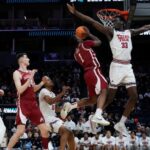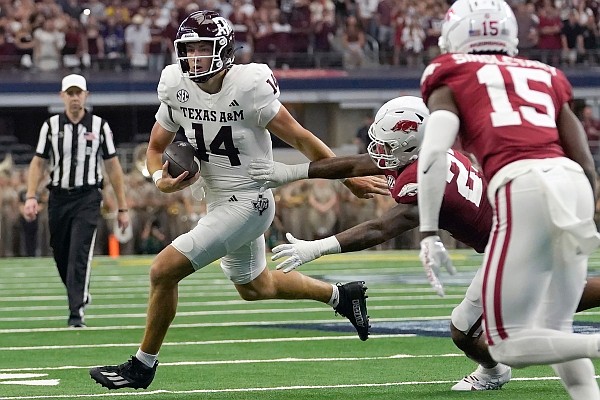Arkansas’ 34-22 loss to Texas A&M is embarrassing largely because Arkansas has no business getting so thoroughly whipped in Year 4 of the Pittman era.
A lot of credit has to go to the Aggies. I thought they might fall apart after that Miami loss, but they didn’t. Then I wondered if they would fall apart when Conner Weigman was lost for the year, but again they didn’t. Bobby Petrino has done a nice job with the offense, but the Aggie defense with all its 5-star talent is their strength. If they can beat Alabama – absolutely possible, even with Max Johnson – then the SEC West may be theirs for the first time ever.
This post will look at the advanced stats, following a deeper look at what has gone so wrong and how Pittman has only one option to fix it.
Advanced Stats
Our model’s pick of 31-18 Aggies ended up being depressingly close. The noise-adjusted score is much lower:

The 26-10 score is considered the actual score for the purposes of our predictive model.
The Aggies lose both of their non-offensive touchdowns here, but gain some points back from those two missed field goal drives. Arkansas loses its pick-six, some points from the field goal drive after the fumble (the Hogs inherited those points, they didn’t gain them on offense), and takes some additional penalties for spending the entire game behind the chains on offense. Not pretty at all.

The Hogs earned a net of 3.2 points on penalties (they committed zero), 7.5 points on field goals, scored a late garbage-time touchdown, and had a pick-six… and lost handily. Arkansas basically did nothing outside of those things. The Aggies didn’t really do much on offense either: they had three turnovers and didn’t run the ball very well.

Arkansas ran 56 offensive plays, and 17 of them were “havoc” plays: a stuffed run, a sack, or a turnover. The Hogs had five three-and-outs and only had three drives get a first down inside the Aggie 40, and one of them was inherited (via a fumble).
The Aggies, meanwhile, moved the ball just fine but struggled to finish drives. They were held to four field goal attempts (missing two) and also failed on fourth-and-goal as time expired. They scored just two offensive touchdowns. The Razorback defense has ceded some yards but has mostly been pretty good when the opponent gets close to the goal line.

We mentioned in the preview that A&M has an elite success rate defense, ranking 2nd in the FBS. And yeah… only 23% of Arkansas’ offensive plays generated positive EPA. That’s hideous. The Hogs were particularly bad on early downs, generating -0.64 EPA per play on standard downs, which meant they were behind the chains for much of the day, finishing with 36% of all plays coming in obvious passing situations because of the down and distance. That’s the main thing a Dan Enos offense is supposed to avoid, and yet, here we are.

We knew coming in that the strength of A&M’s team, talent-wise, is on the defensive line, where the Aggies have a half-dozen former 5-star recruits on the two-deep. However, Auburn was able to have modest success running the ball on them, so I wondered if Arkansas would be able to generate some offense between the tackles. Arkansas ran the ball fine on the first two drives, but things fell apart after that.
Once the talent gap took over, the Aggie defensive front dominated this game.

KJ Jefferson was sacked on 7 of his 24 dropbacks (29%), and Arkansas ended the day with a net of 92 passing yards, or 3.8 per attempt. More than half of the net total came on the 48-yard touchdown pass to Andrew Armstrong when the game was already out of reach.
With 2:30 left in the first quarter, Jefferson hit Rocket Sanders on a screen pass that Sanders took for a 38-yard gain to set up Arkansas’ second field goal drive. Arkansas’ next completed pass came with 1:22 left in the third quarter… more than half the game later (about 31 minutes of gametime).
- Box Score Breakdown: Texas Tech 85, Arkansas 83

- Matchup Analysis: 3 Texas Tech

- Box Score Breakdown: Arkansas 75, St. John’s 66

You can’t out-Alabama Alabama… or out-LSU LSU, out-A&M A&M, or out-BYU BYU
I wrote this back in January when Enos was hired by Arkansas:
It’s always important to know what needs to go right and what the pressure points are. For Travis Williams at DC, the key will be recruiting and development, particularly on the defensive line. That’s obviously true to an extent for Enos too.
For Enos, it’s pretty simple: protecting the quarterback. When Enos offenses go sideways, you can always look at the sack numbers. Enos has never used a lot of max protection because he likes to get his tight ends out into passing routes. And while the quick passing game helps get the QB on rhythm, Enos prefers long-developing passing concepts to push the ball down the field.
In 2016, Austin Allen took 34 sacks and was pressured on more than 40% of dropbacks. In 2019 at Miami, Hurricanes quarterbacks somehow took 51 sacks. Even this year, Maryland QBs took a combined 43 sacks and the team finished 115th out of 130 teams in Adjusted Sack Rate.
When Pittman was hired at Arkansas, the Hogs didn’t have a true talent advantage in any position group on the field. Pittman hired Kendal Briles and Barry Odom to run creative schemes that could create some advantages that could cover for Arkansas’ lack of talent. In the meantime, Pittman and the staff would work on building up that talent base with recruiting and development.
After three years, Pittman apparently decided that the talent base was in a much better place and was now ready to compete in the SEC in equal footing. When Odom left, Pittman replaced him with a much more conventional defensive coordinator. When Briles got annoying and Pittman (apparently) let him walk, he hired Enos, also a more conventional hire.
In hiring Enos, Pittman was gambling that one single position group had “arrived” and was talented enough to win in the SEC: offensive line. If Pittman thought his offensive line was anything other than top-5 in the SEC, then Enos was a terrible hire.
Winning is easy, continuing to win is hard
If you’ve ever wondered by why so many coaches at schools like Arkansas seem to build up and peak quickly in their second or third year and then see their success decline after that, here’s the reason. It seems to be happening to Pittman, and it happened to Bret Bielema before him.
When a coach is hired at a school that fired the previous coach for performance, the coach assumes that, initially, he will lack the talent to compete on equal terms. So he comes up with a short-term plan – get creative to cover for a lack of talent – and a long-term plan – recruit and develop at a high level to eventually compete on talent alone.
The first part is very doable. The second part is very hard. That’s called program building, and it’s really, really difficult. Many coaches have short-term success by adapting their offensive scheme to the players they have or can get in their first recruiting class. But all coaches dream of creating a Saban-like “process” that takes 4-stars as inputs and, like an assembly line, churns out perfectly-developed, scheme-fit players who can overwhelm opponents based on talent alone. But when do you flip the switch to abandon the short-term plan for the long-term one? Pittman obviously flipped it this offseason, probably because the Hogs regressed to 7-6 and he thought some of the gimmicky, “creative” stuff was the problem. He clearly flipped it too early. Forget competing with Alabama and Texas A&M; talent alone isn’t going to be enough to beat BYU. Arkansas has not “arrived” as a program at all.
KJ Jefferson’s “regression” is an offensive regression
An example of this transition from creativity to assembly line would be Jefferson. If you’ve watched him this year, you’ll notice that he doesn’t look like the same player. All of the Heisman talk now seems silly. And a lot of it probably was silly. Jefferson isn’t in the same class as quarterbacks like Caleb Williams and Michael Penix. I would add that Jefferson is also very different from Jalen Hurts, the quarterback cited as evidence of Enos’s QB development abilities. Jefferson has a lot of raw skills: he’s a run threat, he’s very hard to sack, and he has a strong arm. He also takes very good care of the football and rarely puts it in harm’s way. But he lacks the field vision you’d expect from a high-level pro-style passer. He’s not terrible at it, but it’s not his strength.
Briles’ offense covered for this deficiency by giving Jefferson mostly simple reads, often single reads. Briles’ deep passing game is from what his father Art ran at Baylor: deep “option” routes adopted from the old run-and-shoot offense (hence why the old Baylor offense is usually called “veer-and-shoot”). Those shot plays are single reads: Jefferson would know he’s throwing it there before the snap, and he and the receiver will decide the exact route on the fly. Per SEC Stat Cat, in 2021, Arkansas called 32 deep shot plays, gaining 705 yards (22.0 yards per attempt). That gave Arkansas the SEC’s most explosive passing offense easily. Even without Treylon Burks in 2022, the Hogs called 24 and gained 275 yards (11.4 per attempt). In both years, the top three passing concepts used by Briles were RPO passes, Floods, and Shot plays. No other concept had more than 20 reps. What do those have in common? They’re all single reads. Jefferson could identify the coverage pre-snap and decide where he was going with the football.
Enos doesn’t run the deep option routes and he uses fewer and less-creative RPOs; his downfield passing game is a more pro-style route combo scheme where Jefferson has to read the coverage on the fly and go through multiple receivers find the target coming open. This is not Jefferson’s strong suit, and he’s struggling to make decisions quickly. After three years of running an offense that suited their quarterback, the Hogs are now trying to make their quarterback suit the offense.
So now what?
The problem with flipping the switch into program-building mode is that if you mess it up, it will probably cost you your job. Not many coaches can unflip the switch and reconfigure things.
Sam Pittman might be a unique coach that could. Because of the horrors of the Chad Morris era, Arkansas has to be patient with Pittman, who remains a popular figure among fans, even if many of them now want him to retire after this year. I think if Arkansas can show some signs of life, ideally getting to 6-6, but even creeping back to 5-7 might be enough, then Pittman can shake up his offensive staff and go find his next Kendal Briles. Enos and OL coach Cody Kennedy would almost-certainly be sent packing.
Notice we’re only talking about the offense, even though the defense “flipped the switch” too. Well… that switch flip may have worked! Co-DCs Travis Williams and Marcus Woodson have done a pretty good job getting Arkansas’ defense competitive with a pretty traditional scheme. Part of it – most of it, actually – is that they absolutely nailed the transfer portal. Now they’ve lined up several 4-star recruits for next year, so there’s reason for optimism.
All of that hope is dependent on Pittman actually understanding where he went wrong and taking the steps needed to fix it. If the temptation to say “Enos just needs his guys” or “I’m gonna get me another old-school coordinator” creeps in, then this isn’t going to work.
Up Next
Arkansas travels to Oxford to take on Ole Miss, who just won an emotional 55-49 game against LSU. Our model has been fading the Rebels all year and thinks this will actually be a very close game.
Thanks for reading! Be sure to follow us on Twitter and on Facebook.
The latest from Fayette Villains, straight to your inbox
Enter your email to subscribe and receive new post alerts and other updates. You can unsubscribe at any time.
